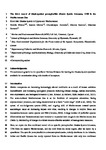The third record of black‐spotted porcupinefish Diodon hystrix Linnaeus, 1758 in the Mediterranean Sea
| dc.contributor.author | Kleitou, P | |
| dc.contributor.author | Giovos, I | |
| dc.contributor.author | Antoniou, C | |
| dc.contributor.author | Ioannou, G | |
| dc.contributor.author | Bernardi, G | |
| dc.date.accessioned | 2020-01-23T12:46:17Z | |
| dc.date.issued | 2020-01-23 | |
| dc.identifier.issn | 0175-8659 | |
| dc.identifier.issn | 1439-0426 | |
| dc.identifier.other | jai.13999 | |
| dc.identifier.uri | http://hdl.handle.net/10026.1/15338 | |
| dc.description.abstract |
Introduction. Marine ecosystems are becoming increasingly altered worldwide as a result of human activities intensification and increasing synergistic pressures including climate change, habitat destruction, over-exploitation, and biological invasions (Crain, Kroeker, & Halpern, 2008; Halpern et al., 2015). The semi-enclosed Mediterranean Sea is at the forefront of ecosystem alterations, facing unprecedented pressures, and being characterized as a basin “under siege” (Coll et al., 2010). The spread of non-indigenous species (NIS), and ongoing shift of Mediterranean coastal species assemblages cause an increasing impact over time, resulting in changes in trophic flows and interactions between native species and NIS (Corrales, 2019). A large number of pufferfish species (Diodontidae and Tetraodontidae) have invaded or expanded their ranges in the Mediterranean Sea (Table 1). Monitoring of changes is critical towards effective adoption of management measures. Here, we report the first confirmed record of the spot-fin porcupinefish Diodon hystrix Linnaeus, 1758 from the eastern Mediterranean, and the third from the entire region, after its report by a spearfisher. | |
| dc.format.extent | 227-230 | |
| dc.language | en | |
| dc.language.iso | en | |
| dc.publisher | Wiley | |
| dc.title | The third record of black‐spotted porcupinefish Diodon hystrix Linnaeus, 1758 in the Mediterranean Sea | |
| dc.type | journal-article | |
| dc.type | Journal Article | |
| plymouth.author-url | https://www.webofscience.com/api/gateway?GWVersion=2&SrcApp=PARTNER_APP&SrcAuth=LinksAMR&KeyUT=WOS:000508655700001&DestLinkType=FullRecord&DestApp=ALL_WOS&UsrCustomerID=11bb513d99f797142bcfeffcc58ea008 | |
| plymouth.issue | 2 | |
| plymouth.volume | 36 | |
| plymouth.publication-status | Published | |
| plymouth.journal | Journal of Applied Ichthyology | |
| dc.identifier.doi | 10.1111/jai.13999 | |
| plymouth.organisational-group | /Plymouth | |
| plymouth.organisational-group | /Plymouth/Faculty of Science and Engineering | |
| plymouth.organisational-group | /Plymouth/Faculty of Science and Engineering/School of Biological and Marine Sciences | |
| plymouth.organisational-group | /Plymouth/Users by role | |
| plymouth.organisational-group | /Plymouth/Users by role/Academics | |
| dcterms.dateAccepted | 2020-01-07 | |
| dc.rights.embargodate | 2021-1-22 | |
| dc.identifier.eissn | 1439-0426 | |
| dc.rights.embargoperiod | Not known | |
| rioxxterms.versionofrecord | 10.1111/jai.13999 | |
| rioxxterms.licenseref.uri | http://www.rioxx.net/licenses/all-rights-reserved | |
| rioxxterms.licenseref.startdate | 2020-01-23 | |
| rioxxterms.type | Journal Article/Review |


